Global Film Locations
The grand tour: eurocrash filming locations.
Published by
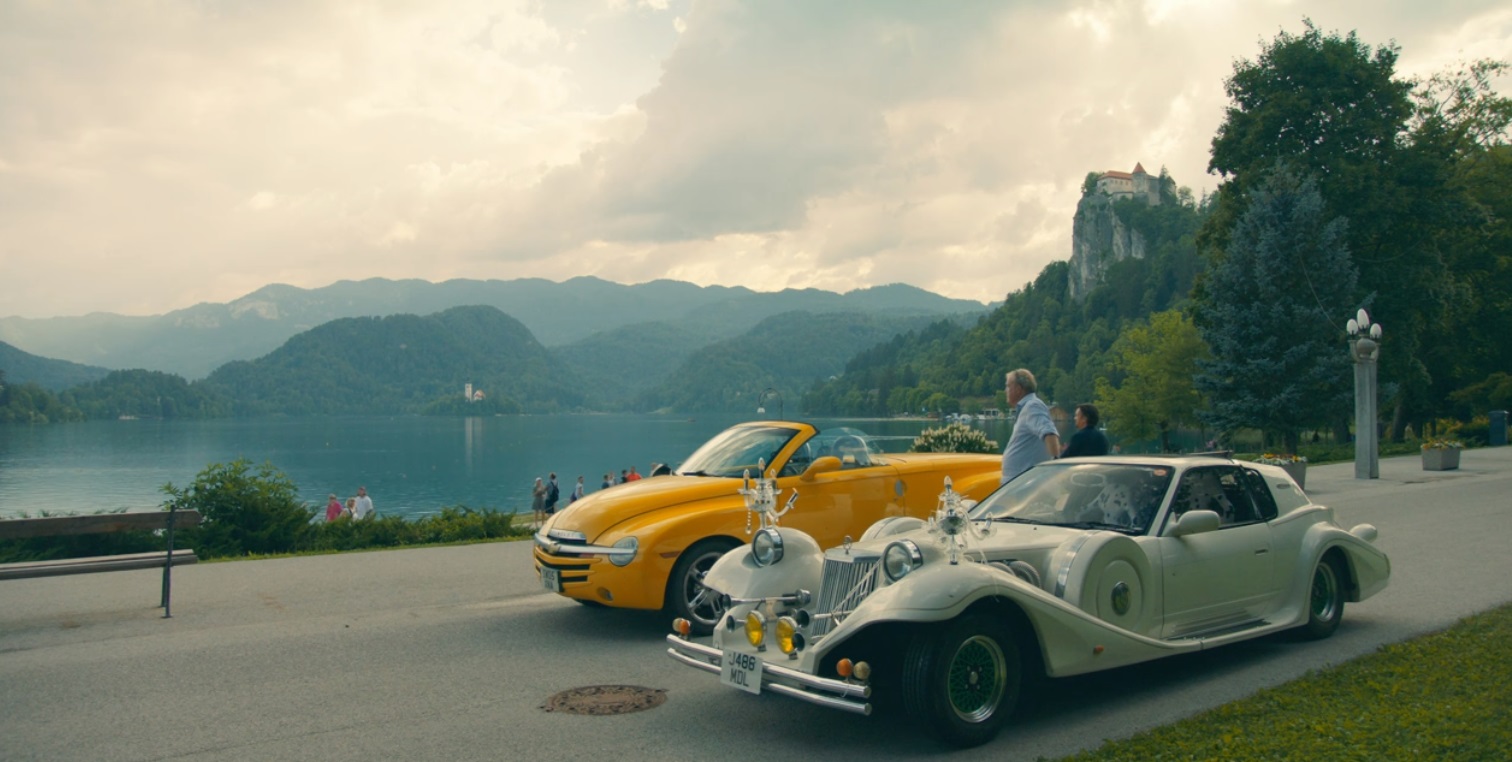
In their latest adventure-filled episode, “The Grand Tour: Eurocrash,” renowned presenters Richard Hammond, Jeremy Clarkson, and James May embark on an exhilarating journey across the captivating landscapes of Europe. Starting their epic road trip in the historic city of Gdańsk, Poland, the trio sets off on a high-octane adventure. From the picturesque streets of Długi Targ to the adrenaline-pumping Tor Poznań racing circuit, they experience the diverse beauty and thrilling experiences that Poland and neighbouring countries has to offer.
Westerplatte, Gdańsk, Poland (Starting point)
Google Maps Co-ordinates: 54.404939, 18.674144

Długi Targ 14-20, 80-828 Gdańsk, Poland
Google Maps Co-ordinates: 54.348216, 18.654491

Tor Poznań, Wyścigowa, Przeźmierowo, Poland
Google Maps Co-ordinates: 52.417036, 16.809261

Pomnik Chrystusa Króla, Sulechowska, Świebodzin, Poland
Google Maps Co-ordinates: 52.236967, 15.546491

GRAPE TOWN HOTEL, aleja Wojska Polskiego, Zielona Góra, Poland
Google Maps Co-ordinates: 51.942754, 15.453917

Stalag Luft III, Żagań, Poland
Google Maps Co-ordinates: 51.600425, 15.308769

Polonia Wax Museum Figury Woskowe, Floriańska, Kraków, Poland
Google Maps Co-ordinates: 50.063869, 19.942598

ARP Piestany Airport , ICAO
Google Maps Co-ordinates: 48.627610, 17.829378

Nordijski center Planica, Rateče, Rateče Planica, Slovenia (Nigel drives down a ski slope)
Google Maps Co-ordinates: 46.475635, 13.723440

Lake Bled, Bled, Slovenia
Google Maps Co-ordinates: 46.369150, 14.107946

Official Trailer
Release: 16th June, 2023
Watch on Amazon Prime

Subscribe For Access To New Content
Leave a reply cancel reply.
This site uses Akismet to reduce spam. Learn how your comment data is processed .
Recent posts
Midnight express (1978) prison location, road house (2024) film locations, old dads (2023) film locations.
Your go-to source for filming locations around the globe.
- Abandoned Places
- Celebrity Graves
- Celebrity Homes
- Celebrity Restaurants
- Cool Places
- Crash Sites
- Did You Know?
- Documentary
- Filming Location Available
- Grand Designs
- Internet Celebrity Homes
- London Filming Locations
- Movie Homes
- Music Video Locations
- Netflix Faves
- Podcast Scripts
- Royal Wedding
- Top Monthly Posts
Designed with WordPress
Discover more from Global Film Locations
Subscribe now to keep reading and get access to the full archive.
Type your email…
Continue reading

Jeremy Clarkson Confirms The Grand Tour’s Final Episode on Amazon Prime
TV presenter Jeremy Clarkson has confirmed the end of The Grand Tour on Amazon Prime after next year. This announcement marks the conclusion of a series beloved by fans since its inception in 2016.
Key Takeaways:
- End of The Grand Tour: Jeremy Clarkson, along with co-presenters Richard Hammond and James May , will no longer film new series of The Grand Tour after next year, following a decision by Amazon Prime’s executives. This marks the end of a popular show that started in 2016 and quickly garnered a devoted fanbase.
- Fan Reactions and Future Prospects: Fans expressed their disappointment and gratitude on social media, reflecting on the impact the show had on their lives. Despite the end of this era, there’s speculation that Amazon Prime may revive The Grand Tour with new hosts, a move reportedly welcomed by the current presenters.
- Clarkson’s Future Endeavours: Clarkson mentioned a focus on his other project, ‘Clarkson’s Farm’, and there are two more special episodes of The Grand Tour slated for release, featuring travels to Mauritania and Zimbabwe.
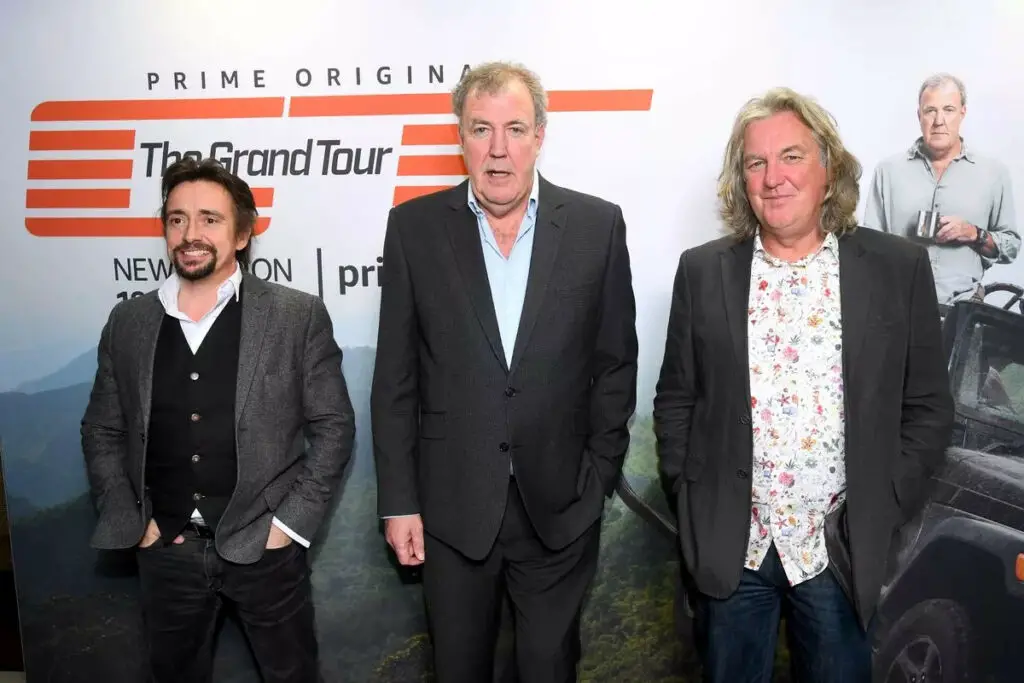
TV presenter Jeremy Clarkson, renowned for his role in the popular car show The Grand Tour alongside Richard Hammond and James May, has recently spoken about the future of the series. The show, which began on Amazon Prime in 2016, has been a fan favourite but will see no further series after next year. This decision, made by the streaming platform’s bosses, brings an end to a series that has been both entertaining and influential for car enthusiasts.
Clarkson shared his thoughts on Instagram, stating:
“Been a busy day. No more Grand Tour after next year but a LOT more Clarkson’s Farm. Which, this evening, is looking extremely lovely.”
This post quickly became a hub for fans to express their feelings about the series ending. The emotional reactions ranged from sadness over the show’s conclusion to appreciation for the years of entertainment it provided.
One fan commented:
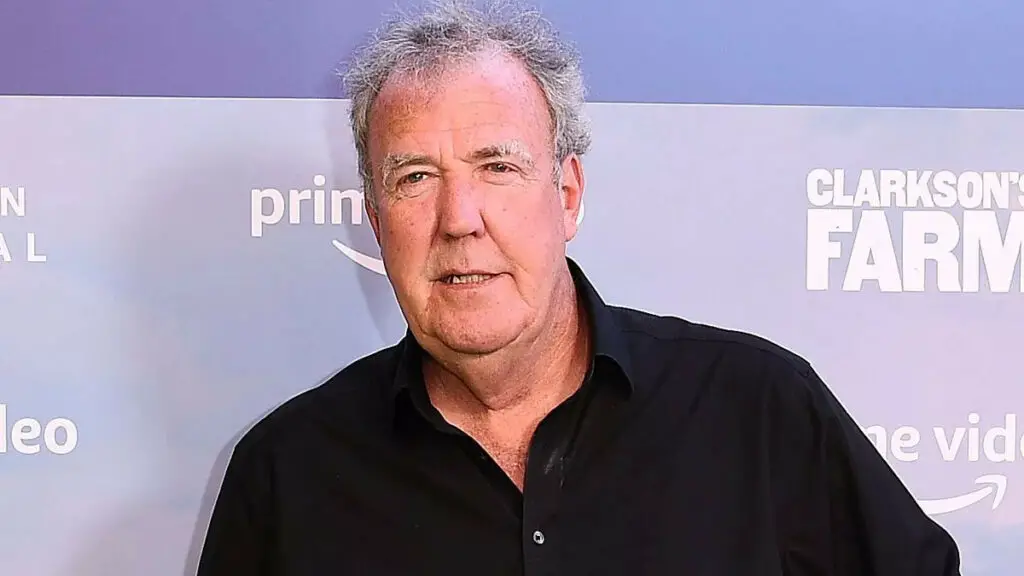
“Please start a podcast with the three of you, it can just be called the news and you rant for an hour about cars.”
Others expressed their gratitude:
“The end of Clarkson, Hammond and May in whatever it’s called is a sad day. Thank you for everything you did for petrolheads. And now farmheads!”
The influence of the trio was evident in another fan’s words:
“It’s really nice coming to the comments and seeing how these 3 impacted the lives of so many. These lads got me through countless dark times with laughter and endless banter. We all knew the day was coming, and the truest of fans will wish you, Hammond, May, and indeed all of the crew that made the magic happen the absolute best in the next stage. Thank you for inspiring countless enthusiasts around the world.”
Despite Clarkson’s announcement, there’s talk that Amazon Prime might continue The Grand Tour with new hosts. An insider revealed:
“It’s a surprising decision and everyone realises it very much marks the end of an era for the three presenters.”
This potential revival aligns with the presenters’ acceptance of passing the torch to a new generation.
“The Grand Tour is one of Prime Video’s most watched shows and Jeremy, James and Richard have a devoted following. But the guys have made no bones about the fact they’re all advancing in years and they have lots of other projects to pursue,” a source informed The Sun. “They just felt like the time was right and wanted to go out on a high when the show remained popular.”
As fans prepare to bid farewell to this iconic trio, they can look forward to two more special episodes of The Grand Tour, showcasing the team’s adventures in Mauritania and Zimbabwe. This farewell follows their departure from Top Gear in 2015, after a disagreement with producers.
Alex Harrington
Jeremy clarkson's health fears: "my body doesn't work anymore" amid dementia concerns, haas f1 team embraces new fia regulations for enhanced 2024 car testing, related articles.
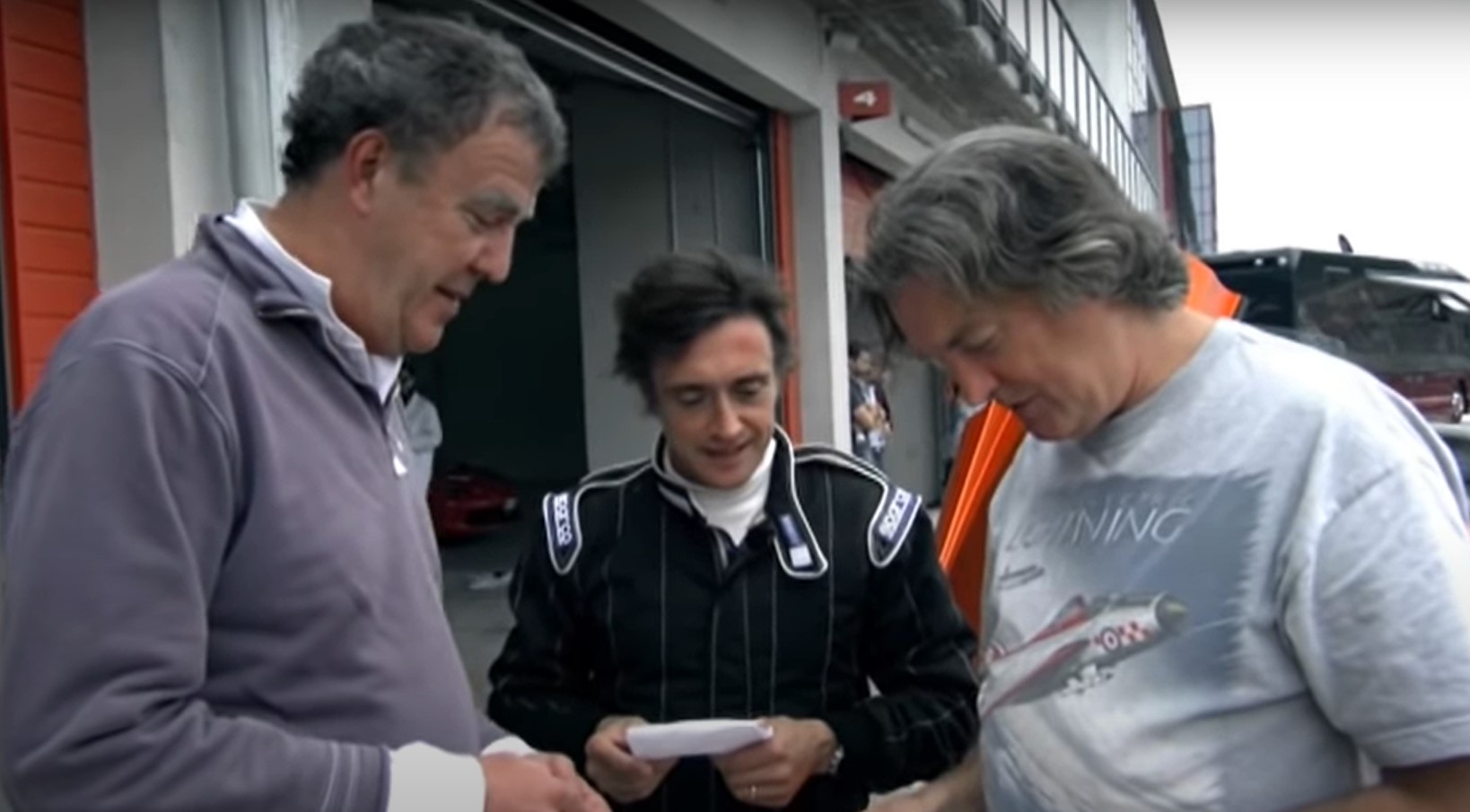
Ex-Top Gear Worker Reveals Just How Much Is Scripted: “It’s Almost Entirely Scripted”
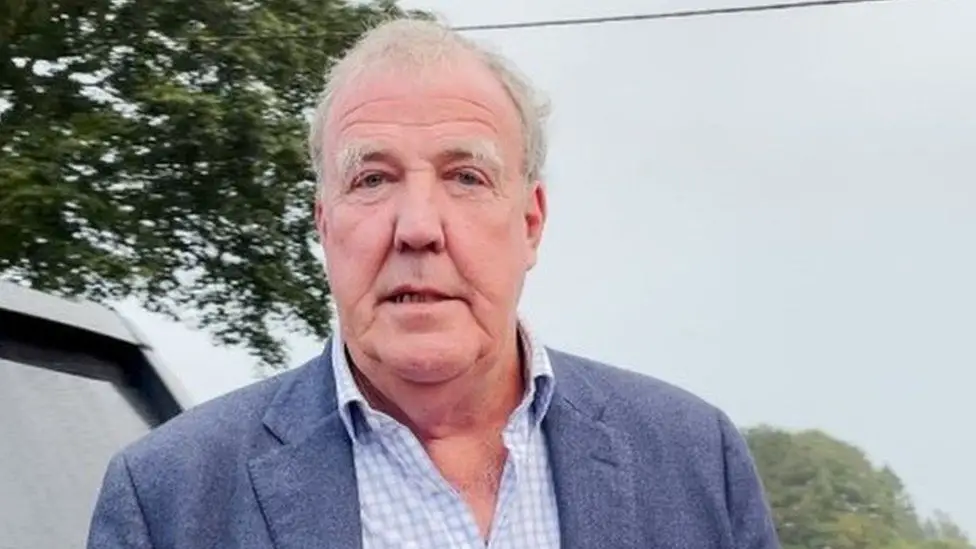
Jeremy Clarkson To Launch Range Of Drinks From Pop To Wine Under New Name

Clarkson’s Farm: Jeremy Clarkson’s Sidekick Receives High Praise By Diddly Squat Insider
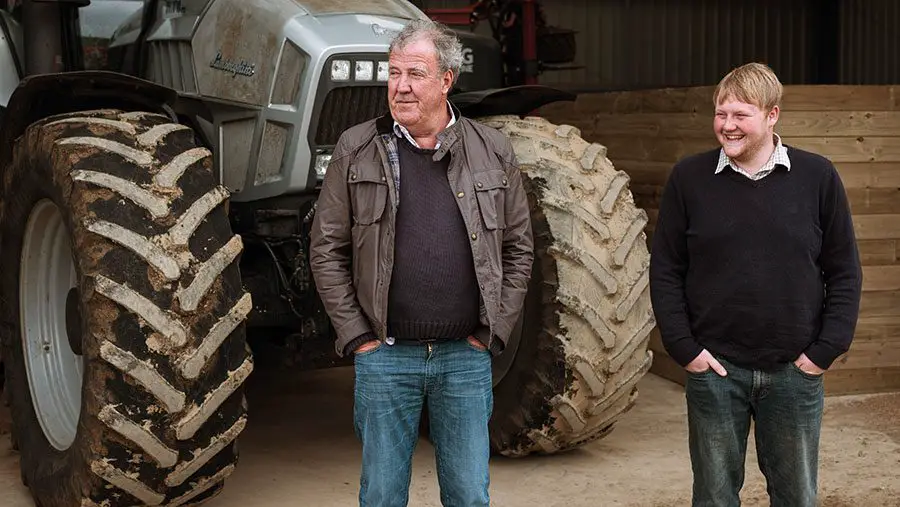
Clarkson’s Farm Season Two: What We Know About The Upcoming Season – Release Date

To bookmark items, please log in or create an account.
Advanced Search Filters
In addition to or instead of a keyword search, use one or more of the following filters when you search.
Experiencing History Holocaust Sources in Context
- Create Account
1 of 14 items in
American Witnesses and the Third Reich
Also in Propaganda and the American Public
Film of General Dwight D. Eisenhower Visiting the Ohrdruf Camp
tags: Americans abroad food & hunger health & hygiene liberation US armed forces
type: Raw Footage
General Dwight D. Eisenhower's visit to the Ohrdruf concentration camp in April of 1945 drew great interest from the American public. His tour of the camp helped generate a massive publicity campaign to expose the crimes of the Nazi regime to the world. The flood of reports that filled Western newspapers and magazines following Eisenhower's visit shocked Americans with grisly details about the Nazi camp system . 1
On April 4, 1945, US Army troops arrived at Ohrdruf, part of the Buchenwald concentration camp system . On April 12, 1945, Eisenhower flew to Ohrdruf to meet American generals George S. Patton and Omar Bradley. The camp was still filled with the bodies of prisoners who had been murdered just before the SS guards fled. The stench of death filled the camp.
The raw footage featured here was taken by members of the US Army Signal Corps. At Ohrdruf, Eisenhower received a tour from former prisoners with a US miitary translator. As the camera rolls, Eisenhower and Bradley solemnly survey the bodies of inmates who were tortured and executed. Crowds of military personnel and former prisoners look on.
Following the discovery of more Nazi concentration camps, Eisenhower cabled US Army Chief of Staff George C. Marshall , declaring that everything that had appeared in the press about these sites was “an understatement." 2 He requested:
If you would see any advantage in asking about a dozen leaders of Congress and a dozen prominent editors to make a short visit to this theater in a couple of C-54s, I will arrange to have them conducted to one of these places where the evidence of bestiality and cruelty is so overpowering as to leave no doubt in their minds about the normal practices of the Germans in these camps. I am hopeful that some British individuals in similar categories will visit the northern area to witness similar evidence of atrocity. 3
Marshall responded the same day, indicating that Secretary of War Henry L. Stimson and President Harry S. Truman had approved his proposal. Eisenhower then arranged with British Prime Minister Winston Churchill for lawmakers from the United Kingdom to see the concentration camps.
Within days of Eisenhower's cable, congressional representatives and journalists toured the camps and publicized their reports. At the same time, footage of liberated camps like this one arrived in the United States, where they were featured in newsreels for viewing in public theaters. Allied occupation authorities then ordered all German prisoners of war in the United States to see these images. In Germany itself, Allied commanders often forced members of the local German population to view the bodies of those killed in the nearby camps or on death marches . German civilians were also forced to exhume the bodies and give them a proper burial. Later, British and American military authorities ordered German townspeople to watch films of Nazi atrocities. 4
Film footage of this kind was also taken at other camps liberated by Allied soldiers. This footage served as evidence in the trials of the major Nazi leaders at Nuremberg in 1945 to 1946 . They were also used to raise public awareness of Nazi crimes and stand today as important and lasting documentation of the Holocaust. 5
For more on what Americans knew about the Holocaust, see the US Holocaust Memorial Museum's citizen history project, History Unfolded .
To learn more about Eisenhower's wartime correspondence with Marshall, see Dear General: Eisenhower's Wartime Letters to Marshall, edited by Joseph Patrick Hobbs (Baltimore: Johns Hopkins University Press, 1999).
Dwight D. Eisenhower to George C. Marshall, April 19, 1945, The Dwight D. Eisenhower Library.
See, for example, this footage footage from Buchenwald taken in 1945.
For another example, see the Experiencing History item, Norman Krasna, "Lest We Forget."
- « Previous
- Next »
This browser does not support PDFs. Please download the PDF to view it: .
All 14 Items in the American Witnesses and the Third Reich Collection
Edward R. Murrow Broadcast from Buchenwald, April 15, 1945
tags: Americans abroad audio-visual testimony food & hunger group violence health & hygiene liberation
type: News Report
Film of Jewish Boycott in Austria
tags: Americans abroad antisemitism fear & intimidation food & hunger politics of fear trade & commerce
type: Home Movie
Photograph of Margaret Bourke-White at Buchenwald
tags: Americans abroad liberation US armed forces visual art women's experiences
type: Photograph
Lothrop Stoddard: "In a Eugenics Court"
tags: Americans abroad eugenics immigration to the US law & the courts people with disabilities propaganda
type: Manuscript
"Richard Hottelet Describes Stay in Dreaded Nazi Prison"
tags: Americans abroad censorship propaganda written testimony
type: Newspaper Article
W. E. B. Du Bois: "A Forum of Fact and Opinion: Race Prejudice in Nazi Germany"
tags: activism Americans abroad antisemitism written testimony
Bishop G. Bromley Oxnam at Buchenwald
tags: Americans abroad Christianity liberation US armed forces
Oral History with Leon Bass
tags: Americans abroad humiliation liberation US armed forces
type: Oral History
Dorothy Thompson Speaks Out on Freedom of the Press in Germany
tags: Americans abroad censorship deportations
type: Newsreel
Carl Schurz Tour of American Professors and Students through Germany in Summer 1934
tags: Americans abroad education propaganda
type: Documentary
Dr. Fritz Linnenbuerger: "Trip to Germany"
tags: Americans abroad propaganda
type: Report
"Personal View of the German Churches Under the Revolution"
tags: Americans abroad Christianity religious life
type: Pamphlet
Film of "Degenerate Art" Exhibition
tags: Americans abroad censorship leisure & recreation propaganda visual art
Archival Information for This Item
Thank You for Supporting Our Work
We would like to thank The Alexander Grass Foundation for supporting the ongoing work to create content and resources for Experiencing History. View the list of all donors and contributors.
Learn more about sources for your classroom

Eisenhower’s Foresight: Protecting the Truth of the Holocaust
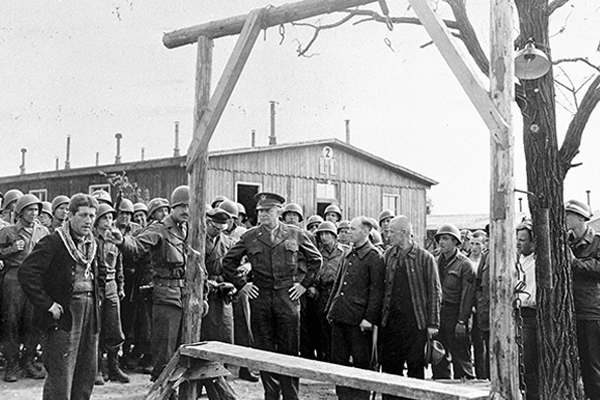
During a tour of the newly liberated Ohrdruf concentration camp in Germany, an Austrian Jewish survivor describes to General Dwight D. Eisenhower and his entourage the use of the gallows in the camp. National Archives
While Supreme Allied Commander Dwight D. Eisenhower had studied his World War II enemy, he was unprepared for the Nazi brutality he witnessed at Ohrdruf concentration camp in April 1945. Bodies were piled like wood and living skeletons struggled to survive. Even as the Allied Forces continued their fight, Eisenhower foresaw a day when the horrors of the Holocaust might be denied. He invited the media to document the scene. He compelled Germans living in the surrounding towns and any soldier not fighting at the front to witness the atrocities for themselves.
On International Holocaust Remembrance Day, join Susan Eisenhower to learn about her grandfather’s vigilance to preserve the truth of the Holocaust, among the topics covered in her most recent book, How Ike Led: The Principles Behind Eisenhower’s Biggest Decisions .
Speaker Susan Eisenhower, Author, How Ike Led: The Principles Behind Eisenhower’s Biggest Decisions Chairman Emeritus, Eisenhower Institute of Gettysburg College
Moderator Dr. Edna Friedberg, Historian, United States Holocaust Memorial Museum
Watch live at facebook.com/holocaustmuseum . You do not need a Facebook account to view our program. After the live broadcast, the recording will be available to watch on demand on the Museum's Facebook page .
Also on January 27 at 1 p.m. ET , the Museum will host a virtual International Holocaust Remembrance Day commemoration . During this ceremony, leaders from the United States and abroad will join Holocaust survivors in conveying the urgent responsibility we all share to protect the lessons and legacy of Holocaust history and to defend the truth—now more than ever.
The Dwight D. Eisenhower Memorial in Washington, DC, which opened in September 2020, complements the Museum’s own Eisenhower Plaza and display of liberating division flags that honor his leadership and the soldiers he commanded. General Eisenhower led the invasion of the European continent that would bring the war in Europe to an end and in so doing, free those remaining Jews and other victims who had survived the Nazi onslaught.
Though liberation of Nazi camps was not a primary objective of the Allied military campaign, US, British, Canadian, and Soviet troops freed prisoners from their SS guards, provided aid to survivors, and collected evidence.
After US soldiers discovered piles of Holocaust victims’ bodies at Ohrdruf, General Dwight D. Eisenhower, Supreme Commander of the Allied Forces in Europe, visited the camp with Generals George S. Patton and Omar Bradley. Later, Eisenhower cabled General George C. Marshall, the head of the Joint Chiefs of Staff in Washington, describing the horrible things he saw there.

Sign Up Today
Start your 14 day free trial today

The History Hit Miscellany of Facts, Figures and Fascinating Finds
15 Holocaust Sites, Museums and Memorials to Visit
Explore the harrowing events and effects of the holocaust through these important sites, museums and memorials around the world..

Harry Sherrin
21 sep 2021.
Between 1942 and 1945, the Nazis embarked upon the so-called ‘Final Solution to the Jewish Question’, a systematic program of extermination. In concentration camps across Europe, 6 million Jewish people were killed – around 78% of all Jews in occupied Europe.
The Holocaust was the most widespread and industrialised act of genocide the world has ever seen.
Today, that devastating moment in modern history is remembered in sites, museums and memorials across the globe. Here are 15 of the most significant, where visitors can learn more about the history of the Holocaust.
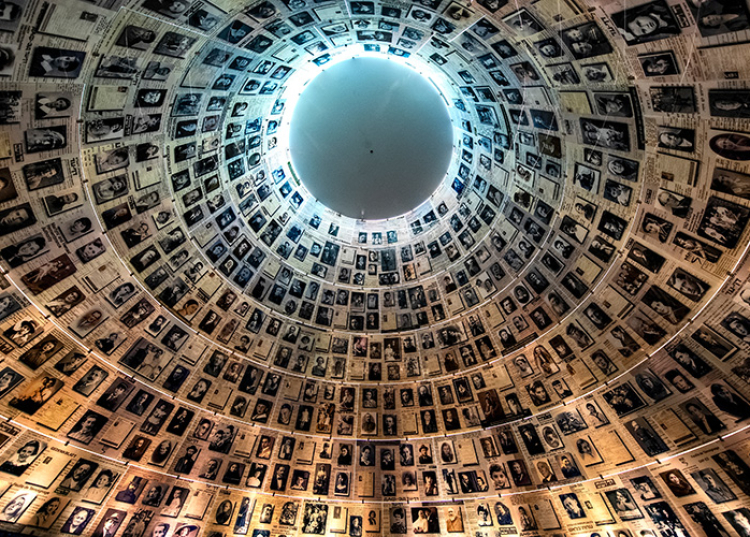
1. Yad Vashem
Yad Vashem in Jerusalem is a museum and a memorial of the Holocaust, in which over six million Jews, and at least five million from other ethnic groups, were murdered in an act of genocide perpetrated by the German National Socialist Party under Adolph Hitler .
Through exhibits including photographs, victims’ accounts, art installations and information panels, Yad Vashem offers a moving – and harrowing – account of the events of the Holocaust.

2. Anne Frank’s House
Anne Frank’s house was the site where German Jewish teenager and Holocaust victim Anne Frank , her family, the van Pels family and later a man called Fritz Pfeffer went into hiding from the Nazis during World War II. Tragically, the group’s whereabouts were betrayed to the Nazis and they were arrested and imprisoned in concentration camps. Anne Frank died in Bergen-Belsen in March 1945, but her diary was later discovered by her father and published to worldwide acclaim.
Anne Frank’s House is now a museum allowing visitors to see the moving bookcase, walk through the cramped secret annex and gain a true appreciation of the hardship this group endured in their fight for survival. The museum has collected and exhibits many original letters, photos and objects belonging to the Frank family as well as to the van Pels and Fritz Pfeffer. Anne Frank’s original diary is also on display.

3. United States Holocaust Museum
The United States Holocaust Memorial Museum in Washington DC is dedicated to commemorating the Holocaust. Combining eyewitness testimony, displayed in films and documents, with over 900 artefacts including one of the railcars used to transport prisoners, the Holocaust Museum tells the story of this world event.
The museum also looks at the issue of genocide as a whole, displaying exhibitions about other atrocities around the world. On average, a tour of the United States Holocaust Memorial Museum takes between 2 and 3 hours.

4. Auschwitz Concentration Camp
Auschwitz Birkenau was a concentration camp founded by the Nazis near the town of Oświęcim or ‘Auschwitz’ in Poland . It became the largest and most infamous camp of them all, central to Hitler’s campaign to exterminate the Jews. By the time Auschwitz was liberated by Soviet forces on 27 January 1945, the camp had claimed 1.3 million lives, the vast majority of whom were Jewish.
Auschwitz Museum is based at the original concentration camp site and offers visitors the chance to pass through the camp’s infamous arches bearing the chilling slogan of “Arbeit macht frei” or “Work will set you free”. Inside, visitors can tour Auschwitz Birkenau individually or in group tours.

5. The Holocaust Memorial - Berlin
The Holocaust Memorial in Berlin is an installation commemorating the genocide of the Jewish people perpetrated under Adolf Hitler and the Nazis. The Memorial is a monument to the six million European Jews who died in the Holocaust.
Made up of a vast dark granite maze and a subterranean information centre which has details about the victims, the memorial is a moving site.

6. Sachsenhausen Concentration Camp
Sachsenhausen Concentration Camp was used by the Nazis between 1936 and 1945. Its primary function was for the imprisonment and execution – or extermination – of Jews and political dissidents, including many Dutch freedom fighters, Russian prisoners of war and even some political leaders from invaded countries.
Estimates put the number of Sachsenhausen casualties at between 30,000 and 35,000, many of whom were shot, hung or exterminated in a specially built room in its infirmary. Much of Sachsenhausen was destroyed during and after its liberation by Soviet and Polish troops on 22 April 1945, but was rebuilt as part of the project to turn it into a memorial and museum.

7. Warsaw Ghetto
The Warsaw Ghetto was established by the Nazis to forcibly house the city’s Jewish population, with up to 400,000 people confined here from October 1940. In 1943, the Warsaw Ghetto Uprising took place, a dramatic rebellion which occurred when the Nazis attempted to liquidate the ghetto and one which saw it razed to the ground.
Very little of the Warsaw Ghetto survives today. There are fragments of the original ghetto wall and several memorials including the Mila 18 monument where the uprising headquarters were located and an inscription where insurgent leader Mordechaj Anielewicz and the last of the uprising fighters perished. There is also the Warsaw Ghetto Fighters Monument and a monument at Umschlagplatz , the site from where Jews were transported to the death camps .

8. Haus der Wannsee-Konferenz
The Haus der Wannsee-Konferenz was the site of the infamous Wannsee Conference in which the Nazis planned how to carry out the “Final Solution”, the plan to murder the Jewish population of Eastern Europe.
Today, the site provides a moving memorial to the Holocaust as well as an in-depth history of the rise of the Nazi party, the growth of anti-Semitism and the atrocities committed against the Jews.

9. Dachau Concentration Camp
Dachau Concentration Camp was one of the first of many concentration camps set up by the Nazis to imprison and murder certain groups as part of their campaign of genocide.
Today, Dachau houses a memorial to those who suffered and perished under the Nazis. Visitors can tour the grounds and the remains of the camp and audio guides are available as are guided tours. There are several exhibitions detailing the history of the camp as well as a documentary shown at various times.

10. Jewish Museum - Berlin
The Jewish Museum in Berlin in Germany chronicles the history of German Jews over the course of two millennia. Housed in an incredibly modern building, the Berlin Jewish Museum displays historical objects, documents, photographs, multimedia presentations and even computer games relating to different periods of Jewish history and culture.
The exhibitions are arranged chronologically and cover various themes such as the living conditions of German Jews over the centuries, the role of Jewish women, tradition and change and the meaning of emancipation. The museum also looks at the issue of persecution, in particular during the Nazi era and the Holocaust, offering an insight into both the overall historical context and the lives of individual victims of the atrocities.

11. Theresienstadt Concentration Camp
Theresienstadt Concentration Camp in Terezin in the Czech Republic was a Nazi concentration camp during the Holocaust. Theresienstadt was originally an 18th-century stronghold known as Terezin Fortress. It was taken over during the Nazi occupation of the then Czechoslovakia in World War Two. Some 30,000 prisoners died at the camp, despite Nazi attempts to portray it as a humane institution.
Today, Theresienstadt Concentration Camp is open to the public and includes a museum as well as the possibility of visiting the former ghetto.

12. Krakow Ghetto Wall
Krakow Ghetto Wall is a stark reminder of the Krakow Ghetto, established by German Nazi forces in March 1941 as part of their campaign to persecute the Jews. Much of the Jewish population had already been conscripted to carry out forced labour since 1939, when the Nazis occupied Poland. In 1942, Krakow Ghetto was closed and all of its inhabitants were sent to concentration camps.
Some inhabitants of Krakow Ghetto were saved during the War by Oskar Schindler, whose famous Schindler’s List was made into a film by Hollywood director, Stephen Spielberg. Now, the Ghetto Wall, flanked by a former ghetto home, is the last remaining wall of those which once bordered Krakow Ghetto. The Ghetto Wall bears a plaque commemorating Krakow Ghetto.

13. Mauthausen Concentration Camp
Mauthausen Concentration Camp or ’KZ Mauthausen’ was a vast Nazi concentration camp in northern Austria. First established in 1938, Mauthausen Concentration Camp was built through the slave labour of prisoners from another such camp, Dachau. Over 119,000 of the almost 200,000 prisoners at Mauthausen Concentration Camp had died there by the time it was liberated by American forces on 5 May 1945.
Today, Mauthausen Concentration Camp is open to the public, who can see the original camp and the terrible conditions to which prisoners were subjected. There is a visitor centre and many memorials to the different national, ethnic and religious groups who suffered at Mauthausen.

14. Burgkloster
The Burgkloster (Castle Monastery) in Lubeck is considered to be one of the most important medieval monasteries in Germany. Established in 1229, the Burgkloster served as a monastery until the Protestant Reformation, after which it was used as a poorhouse until the 19th century. Under the Third Reich, the Burgkloster was used as a Nazi prison, bearing witness to terrible atrocities, particularly against Jews and those who formed the resistance movement.
Today, the Burgkloster is a museum of Lubeck’s history. Visitors can tour the building as well as viewing exhibits on the history of Lubeck’s Jewish community and about Lubeck’s time as an important member of the Hanseatic League. This was a medieval trade block which controlled much of the North Sea and Baltic Sea.

15. Tolerence Center
The Tolerence Center is one branch of the Vilna Gaon State Jewish Museum. A permanent exhibit operates at the Tolerance Center featuring the historical cultural and artistic heritage of the Litvaks, the Jewish community in Lithuania.
The displays include unique relics of the Great Synagogue of Vilnius and Jewish folk and professional art. The non-permanent exhibits, thematic events and projects are oriented toward themes including the cultural education of society, social dissemination of culture, unique cultural heritage and fundamental human rights.

MEMORIAL AND MUSEUM AUSCHWITZ-BIRKENAU FORMER GERMAN NAZI CONCENTRATION AND EXTERMINATION CAMP
The post-camp relics are protected by the Museum created in 1947. The Memorial today is i.a. the Archive and Collections as well as research, conservation and publishing center.
- Auschwitz Council
- Preservation
- Historical collection
- Museum Reports
- Projects EU
- Museum Structure
- History of the Memorial
- Photo gallery
- Auschwitz prisoners
KL Auschwitz was the largest of the German Nazi concentration camps and extermination centers. Over 1.1 million men, women and children lost their lives here.
- Home Page - History
- Before the extermination
- Auschwitz I
- Auschwitz II
- Auschwitz III
- Auschwitz sub-camps
- Auschwitz and Shoah
- Categories of prisoners
- Fate of children
- Prisoner classification
- Life in the camp
- Punishments and executions
- Camp hospitals
- Medical experiments
- Informing the world
- The number of victims
- The SS garrison
- Holocaust denial
- Auschwitz Calendar
The authentic Memorial consists of two parts of the former camp: Auschwitz and Birkenau. A visit with an educator allows better understanding of this unique place.
- Home Page - Visiting
- Preparation and summary of a visit
- Reservation
- Tours options
- Online guided tours
- Rules for Visiting
- Opening hours
- Temporarily closed for visitors
- Getting to the Museum
- Permanent Exhibition
- National Exhibitions
- On-line Exhibitions
- Virtual tour
- Plan your visit
- Information plaques
There is no way to understand postwar Europe and the world without an in-depth confrontation between our idea of mankind and the remains of Auschwitz.
- Home Page - Education
- Study visits
- Educational projects
- Conferences
- Thematic sessions
- Exhibitions
- Visiting the Memorial
- Publications
- Volunteer Bureau
- Resources for teachers
- ICEAH – General Information
- Light of Remembrance
- Library - Online Catalogue

Google Supports the Online Guided Tours of the Auschwitz Memorial
Google will support the development of the "Auschwitz in Front of Your Eyes" project, enabling people from around the world to visit the former German Nazi concentration and extermination camp Auschwitz-Birkenau with a live guide in an online format. Through $1M in funding and support from Google.org, Google’s philanthropic arm, the Memorial will expand education about Auschwitz and the Holocaust to reach people everywhere.

"Auschwitz. Not long ago. Not far away" exhibition in Boston
The travelling exhibition created by the Auschwitz Museum and the Spanish company Musealia was opened at The Castle at Park Plaza in Boston on 14 March. It will be on display there until 2 September.

"To reach people in the most remote corners of the world". The launch of the online tours of the Auschwitz Memorial.
"Auschwitz in Front of Your Eyes" is an application through which millions of people from around the world will gain access to education conducted directly from the authentic Memorial Site. It allows an online guided tour of the former German Nazi camp. Reservations: visit.auschwitz.org .

New online bookstore of the Museum
The new online bookstore of the Museum is now available at books.auschwitz.org . In addition to printed publications in many languages, ebooks are also available on the website.

New research laboratory of the Museum conservators
A new research laboratory was opened at the Auschwitz Museum. It will allow specialized research on objects from the German Nazi concentration and extermination camp Auschwitz.
The new laboratory is equipped to carry out physicochemical research and molecular biology analysis, including microbiology and genetics.

Today, once again, comes the time for essential human choices. 78th anniversary of liberation of Auschwitz.
On January 27, a group of 18 Auschwitz and Holocaust Survivors met at the former Auschwitz camp to commemorate the 78th anniversary of the liberation of this German Nazi concentration and extermination camp. The main theme of the anniversary was the process of planning, creating and expanding the system of dehumanisation and genocide at Auschwitz, which was particularly strongly defined by the words of survivor Marian Turski 'Auschwitz did not fall from the sky'.
ONLINE LIVE GUIDED TOURS OF THE AUSCHWITZ MEMORIAL FOR GROUPS AND INDIVIDUAL VISITORS

84th anniversary of the first transport of Poles to Auschwitz - 14 June 2024

"Preserve Authenticity" - online educational session on preservation - 28 May 2024.

31st March of the Living

Memoria Magazine no. 79

Call for participants of the German-Polish seminar “How to Deal with Difficult Past?”


Prof. Marc van Berkel appointed Honorary Consul of the Auschwitz Memorial in the Netherlands

Camp chess pieces found in one of the historic buildings

Volunteers from the Brynek Forestry Technical School help protect the Museum's green spaces

Memoria Magazine no. 77

"A piece of the world surrounded by barbed wire..." The fate of Polish citizens in KL Auschwitz - a new temporary exhibition
- Nasz profil na facebook
- via @auschwitzmuseum"> Udostępnij na Twitter
- Nasz profil na Pinterest
- Nasz profil na YouTube
Auschwitz Memorial / Muzeum Auschwitz
Wyświetl ten post na Instagramie. "Come here you free citizen of the world, whose life is safeguarded by human morality and whose existence is guaranteed through law. I want to tell you how modern criminals and common bandits have betrayed the morality of life and nullified the postulates of existence." - Zalman Gradowski, member of Sonderkommando at Auschwitz, murdered during the uprising on October 7, 1944. Auschwitz I. Block 27. Shoah exhibition. --- Photo by @tofudonbe --- #Auschwitz #Birkenau #AuschwitzMemorial #Nazi #Germany #concentrationcamp #extermination #genocide #history #Holocaust #Shoah #Jews #Poles #Roma #people #life #death #humanity #humiliation #dehumanization #remembrance #commemoration #memory #museum #Poland #igerspoland #UNESCO #worldheritage #worldHeritagelist @unesco #photography Post udostępniony przez Auschwitz Memorial and Museum (@auschwitzmemorial) Paź 27, 2019 o 11:17 PDT
Images from www.auschwitz.org may be used only in publications relating to the history of the German Nazi concentration and extermination camp Auschwitz-Birkenau or the activities of the Auschwitz Memorial. Their use must not tarnish the good reputation of the victims of KL Auschwitz. Any interference in the integrity of the images – including cropping or graphic processing – is prohibited. The use of the images for commercial purposes requires the Museum’s approval and information about the publication. Publishers undertake to indicate the authors and origin of the images: www.auschwitz.org, as well as to inform the Museum of the use of the images ([email protected]).
Rated 98% based on 1029 reviews

UK 0345 475 1815 USA (toll free) 877‑209‑5620 International 00 44 345 475 1815 [email protected] Rated 98% on feefo
Sign-in Latest News Subscribe Request Brochure
- Future Planning
- Military History and Battlefield Tours
- Classical History and Archaeological Tours
- Holocaust Tours
- General History Tours
- Experience Tours
- Walking Tours
- Early Periods
- 17th & 18th Century
- Victorian Era
- First World War
- Second World War
- Cross-Periods
- Destinations
- Our Expert Historians
- Historians Q&A
- Historical Tailor Made Tours
- School Tours
- Battlefield Studies
- Testimonials
- What to Expect
- Activity Levels
- Tour Diaries & Images
- Our Library
- Frequently Asked Questions
- Work For TCE
- General Booking Conditions
- Download Booking Form
- Tours by Date
- Tours by Theme
- Tours by Period
- Tours by Destination
- Latest News
- Request Brochure
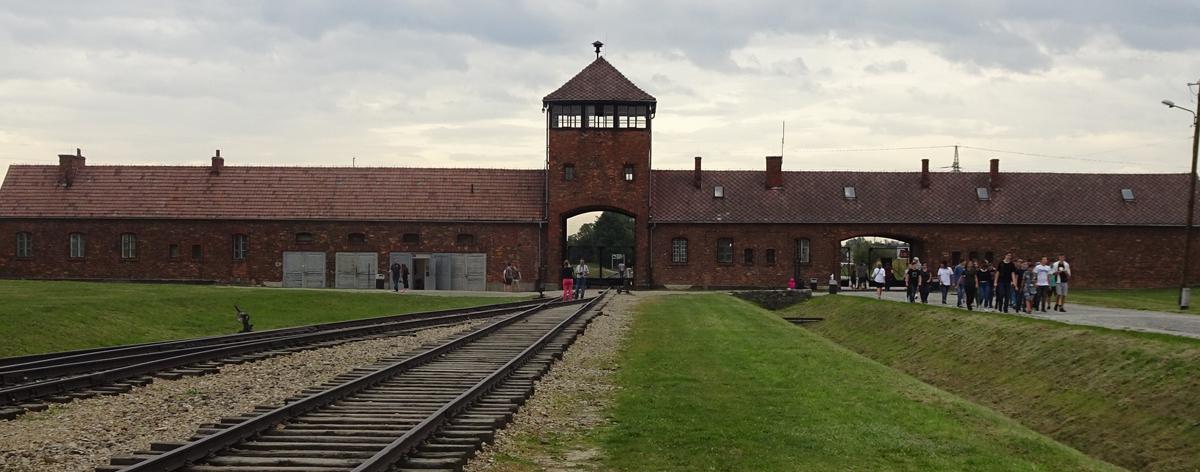
- The Holocaust
Poland and the Nazi Death Camps
Experience Tours General History Tours Holocaust Tours
26th June - 3rd July 2024 (8 Days)
Expert Historian : Professor Alexander Korb
Tour price: £2,800
click here to book
MORE DATES AVAILABLE BELOW
Your Holiday Essentials
26th June - 3rd July 2024 (8 Days)
4-star hotels, meals as indicated,
drinks with dinner, all entrance
fees, tour manager and expert
historian throughout, all internal
travel, optional travel from UK.
Activity Level : 2
Standard price: £2,550
Incl. travel from UK: £2,800 Room sole occupancy supplement: £315 Non-refundable deposit: £275
Booking open
Interested in this tour but not ready to book? Register your interest using the link below and we will keep you updated on the progress of the tour.
click here to register your interest
28th August - 4th September 2024 (8 Days)
Expert Historian : Dr Isabel Wollaston
2nd - 9th October 2024 (8 Days)
Expert Historian : Martin Winstone
Last few places
Tour Introduction
In this 8-day tour to Poland, we visit the sites of the former ghettos in Warsaw, Lublin and Krakow alongside four of the concentration and death camps - Treblinka, Majdanek, Belzec and Auschwitz-Birkenau - that played such a significant role in this genocide. We look at the struggle of both the Jews and the Poles against their oppressors,visiting the scenes of Ghetto Uprising in 1943 and the memorial to the Warsaw Rising in 1944. You will see the shift from complete physical destruction of ghetto and camp to the actual remnants due to the rapid advance of the Soviets. However, the tour is not limited to the serious and emotive history of the Holocaust, with its clear message for future generations. We also enjoy expert guided tours of the historic cities of Warsaw and Krakow. We sample much of the local culture and visit the world famous salt mine at Wieliczka. Each evening we will dine in a different local restaurant to enjoy a wealth of diverse local cuisine. The topography of the sites we visit involves a fair amount of walking: at Auschwitz/Birkenau you will cover almost 8 miles over the course of the day, but that is necessary to achieve a full appreciation of the subject.
Read reviews of this tour by past travellers
Under Communism, in Poland it was traditional to refer to ‘six million Poles murdered during World War II, a figure that referred to 3 million ethnic Poles and 3 million Polish Jews. Those Polish Jews were murdered in ghettos, forests in the east of the country, or purpose-built death camps set up after the German occupation of Poland. By far the largest of these was Auschwitz-Birkenau, which was the site of over one million deaths, mainly Jews brought here from all over Europe. The smaller, purpose built 'killing' camp of Treblinka, where Warsaw's Jews were taken, was said by its commandant SS-Obersturmfuhrer Franz Stangl to be able to murder over 1000 people per hour at its peak. With the positioning of the Majdanek camp on the outskirts of Lublin, the Germans made no effort to disguise the killings, its gas chambers and crematorium being plainly visible to passers-by. The overarching narrative of the tour is about the shift from Polish Jews to European Jews and the evolution of policy from concentration camps to death camps.
- With Dr Isabel Wollaston , Prof Alexander Korb or Martin Winstone
- See parts of ghetto walls in Warsaw
- The POLIN Museum of the History of Polish Jews
- Treblinka memorial and museum
- The multi-purpose prisoner of war camp, concentration camp and death camp at Majdanek, on the outskirts of Lublin
- Belzec camp and museum
- Guided tour of the architectural wealth of Krakow's Old Town, and former Jewish quarter in Kazimierz, now a major cultural and heritage site (and which featured heavily in Steven Spielberg’s film Schindler’s List.
- Full day at Auschwitz and Birkenau
- Visit the awesome 700 year old salt mine at Wieliczka
What's Included
- Return flights from London (optional)
- 4 Star Hotels
- Buffet breakfast each morning
- A three-course dinner party on 6 evenings hosted by your expert historian and tour manager
- Two drinks i,e wine or beer at each dinner and a welcome drink on first evening
- Dedicated Tour Manager
- Entrance fees for sites included in itinerary
- Modern, comfortable, air-conditioned coach
- Tour information booklet
- Access to the Cultural Experience app
- Helpful and friendly travel advice
- The company of like-minded travelers
"All in all an incredibly enriching and moving experience, I am so glad I went with The Cultural Experience. With the guides vast expertise brought everything to life. Examining events in chronological order was an amazing way to learn".
"One doesnt need to be an expert hiker for this tour, but you need a lot of stamina there is a lot of walking and standing, often for hours, with nowhere to sit down and rest...this was an amazing once in a lifetime experience...I thought I understood the Holocaust, but I had only superficial knowledge. I have learned so much."
Day 1 - Depart
We fly from London to Warsaw before checking-in to our central hotel for two nights. (D)
Day 2 - Warsaw
A busy day exploring the Polish capital on foot to explore the key sites associated with the former ghetto and its subsequent uprising: the POLIN Museum of the History of Polish Jews, the Umschlagplatz (a holding area set up by Nazi Germany) and the Warsaw Jewish cemetery, one of the largest Jewish cemeteries in the world.(B,D)
Day 3 - Treblinka & Lublin
This morning we drive to the extermination camps at Treblinka, where between 700,000 to 900,000 Jews lost their lives. Operational between July 1943 and October 1943, more Jews lost their lives at Treblinka II than at any other death camp, other than Auschwitz. Spend time in the small but informative museum before visiting the memorials to those who lost their lives. We spend the night in Lublin, a city which had a large pre-war Jewish population and which served as the administration centre for Action Reinhardt. (B,D)
Day 4 - Belzec & Majdanek
Our day will begin at the concentration camp of Majdanek, just on the outskirts of Lublin, where approximately 80,000 people from 28 different countries lost their lives. Today it is a well-preserved Nazi concentration and death camp where we find barracks, guard towers, gas chambers, crematoria, museum, “Gates of Hell” memorial and the mausoleum memorial, a gigantic structure which contains the ashes of victims beneath it. Continue to Belzec, the small but lethal death camp, where between 430,000 & 500,000 Jews lost their lives in six-months with as a few as 7 people surviving. Our hotel for the evening is based in Rzeszów. (B,D)
Day 5 - Krakow
This morning we drive to Krakow where we take a change of pace and emphasis with an afternoon orientation tour of Krakow's Old Town and its busy street life. Check-in to our hotel for three nights.(B,D)
Day 6 - Auschwitz and Birkenau
An early start as we are immersed in a comprehensive tour on foot of the concentration and death camps of Auschwitz and Birkenau. To enter the camp of Auschwitz, one passes under the infamous inscription 'Arbeit Macht Frei' mounted upon its main gate, before visiting the exhibitions in the surviving prison blocks. In the afternoon we visit Birkenau, also known as Auschwitz II, the purpose-built camp that had hundreds of barracks and 4 massive gas chambers and functioned as the epicentre of the Holocaust during 1943 and 1944. The day at Auschwitz and Birkenau explores two large camps and will involve a good amount of walking. This evening you are free to find your own restaurant for dinner and perhaps explore Krakow. (B)
Day 7 - Kazimierz and Wieliczka
Before WW2, some 70,000 Jews lived in Krakow, mostly in the suburb of Kazimierz. We explore this tiny area including the Old Synagogue Museum and there will be an opportunity for an optional unaccompanied visit to the museum situated in the former Oscar Schindler's Factory. We visit the awesome 700-year-old salt mine at Wieliczka, its labyrinth of 300km of tunnels revealing chapels, underground lakes and a museum. (B,D)
Day 8 - Home
Transfer to Warsaw airport for your return flight to London. (B)
Recommended Reading List
- Auschwitz : The Nazis & The 'Final Solution'
- Holocaust Landscapes
- Marching into Darkness: The Wehrmacht and the Holocaust in Belarus
- Ordinary Men
- Survival in Auschwitz: The Nazi Assault on Humanity
- Traces of the Holocaust: Journeying In and Out of the Ghettos

Professor Alexander Korb
Alexander Korb was director of the Stanley Burton Centre for Holocaust and Genocide Studies between 2012 and 2018. Alexander is an expert of the Holocaust in Central and Southeastern Europe. Moreover, he specializes in the history of genocide, of international relations within wartime Europe, and in a transnational intellectual history of right-wing Europe.
Photo Gallery
- SS Canteen, Auschwitz I
- Isabel guiding the group at Majdanek
- Warsaw Uprising Monument
- Group picture inside Wieliczka Salt Mine
- Auschwitz Train
- Anne & Margot Frank Memorial
Tour Reviews
Take a look at some independent reviews of this tour by previous participants here
Take a look at some of the images taken on our most recent tour
View a diary of our Holocaust tour here
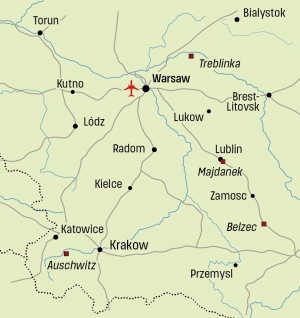
direct link
Subscribe to Our E-Newsletter
For up to date news as well as details about all of our tours please subscribe to our fortnightly e-newsletter

Quick Links
Military History and Battlefield Tours Classical History and Archaeological Tours Holocaust Tours General History Tours Experience Tours Walking Tours Future Planning Request Brochure Site Map
The Cultural Experience 11B Mansfield Park Four Marks Alton GU34 5PZ United Kingdom
UK: 0345 475 1815 USA (toll free): 877 209 5620 International: 00 44 345 475 1815
© 2015 - 2024 Midas Tours Ltd - Hosted by SWD - Legal Info - Terms of Use - Privacy Policy / Cookies - Sign-in
Search the Holocaust Encyclopedia
- Animated Map
- Discussion Question
- Media Essay
- Oral History
- Timeline Event
- Clear Selections
- Bahasa Indonesia
- Português do Brasil
Featured Content
Find topics of interest and explore encyclopedia content related to those topics
Find articles, photos, maps, films, and more listed alphabetically
For Teachers
Recommended resources and topics if you have limited time to teach about the Holocaust
Explore the ID Cards to learn more about personal experiences during the Holocaust
Timeline of Events
Explore a timeline of events that occurred before, during, and after the Holocaust.
- Introduction to the Holocaust
- Antisemitism
- How Many People did the Nazis Murder?
- Book Burning
- German Invasion of Western Europe, May 1940
- Voyage of the St. Louis
- Genocide of European Roma (Gypsies), 1939–1945
- The Holocaust and World War II: Key Dates
- Liberation of Nazi Camps
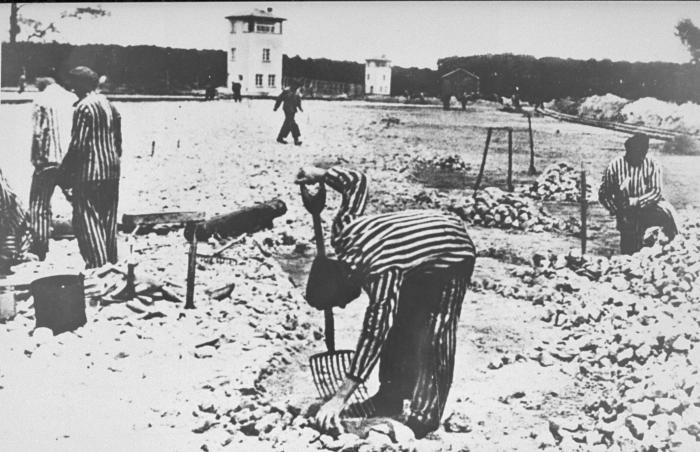
Concentration Camps, 1933–39
During the first six years of the Nazi regime, thousands of Germans were detained or confined extra-legally. The conditions were usually harsh and there was no regard to the legal norms of arrest and imprisonment of a constitutional democracy in terms of arrest and imprisonment.
Nazi officials established the first concentration camp, Dachau, on March 22, 1933, for political prisoners. It was later used as a model for an expanded and centralized concentration camp system managed by the SS.
What distinguishes a concentration camp from a prison (in the modern sense) is that it functions outside of a judicial system. The prisoners are not indicted or convicted of any crime by judicial process.
The major purpose of the earliest concentration camps during the 1930s was to imprison and intimidate the leaders of political, social, and cultural movements that the Nazis perceived to be a threat to the survival of the regime.
- concentration camps
- forced labor
This content is available in the following languages
Concentration camps ( Konzentrationslager ; abbreviated as KL or KZ) were an integral feature of the regime in Nazi Germany between 1933 and 1945.
The term concentration camp refers to a camp in which people are detained or confined, usually under harsh conditions and without regard to legal norms of arrest and imprisonment that are acceptable in a constitutional democracy.
The First Concentration Camps in Germany
German authorities established camps all over Germany on an ad hoc basis to handle the masses of people arrested as alleged subversives. The SS established larger camps in Oranienburg , north of Berlin; Esterwegen, near Hamburg; Dachau , northwest of Munich; and Lichtenburg, in Saxony. In Berlin itself, the Columbia Haus facility held prisoners under investigation by the Gestapo (the German secret state police) until 1936.
Centralization of the Concentration Camp System
After December 1934, the SS became the only agency authorized to establish and manage facilities that were formally called concentration camps. Local civilian authorities did continue to establish and manage forced-labor camps and detention camps throughout Germany. In 1937, only four concentration camps were left: Dachau , near Munich; Sachsenhausen near Berlin; Buchenwald near Weimar; and Lichtenburg near Merseburg in Saxony for female prisoners.
Purposes of the Camp System
Concentration camps are often inaccurately compared to a prison in modern society. But concentration camps, unlike prisons, were independent of any judicial review. Nazi concentration camps served three main purposes:
- To incarcerate people whom the Nazi regime perceived to be a security threat. These people were incarcerated for indefinite amounts of time.
- To eliminate individuals and small, targeted groups of individuals by murder, away from the public and judicial review.
- To exploit forced labor of the prisoner population. This purpose grew out of a labor shortage.
Concentration Camp Administration
Already as commandant of Dachau in 1933, Eicke developed an organization and procedures to administer and guard a concentration camp. He issued regulations for the duties of the perimeter guards and for treatment of the prisoners. The organization, structure, and practice developed at Dachau in 1933–34 became the model for the Nazi concentration camp system as it expanded. Among Eicke's early trainees at Dachau was Rudolf Höss, who later commanded the Auschwitz concentration camp.
Special “political units on alert” ( Politische Bereitschaften ) originally guarded the SS concentration camps. They were renamed “SS Guard Units” ( SS-Wachverbände ) in 1935 and “SS Death's-Head Units” ( SS-Totenkopfverbände ) in April 1936. One SS Death's-Head Unit was assigned to each concentration camp. After 1936, the camp administration, including the commandant, was also a part of the SS Death's-Head Unit.
Although all SS units wore the Death's-Head symbol (skull and crossbones) on their caps, only the SS Death's-Head Units were authorized to wear the Death's Head Symbol on their lapels. The “SS Death's-Head Division” of the Waffen SS was created in 1940. Its officers were recruited from concentration camp service. They also wore the Death's-Head symbol on their lapel.
The SS Death's-Head Unit at each camp was divided into two groups. The first was the camp staff, which covered:
- the commandant and his personal staff
- a Security Police officer and an assistant to maintain and update prisoner records
- the commandant of the so-called protective detention camp ( Schutzhaftlagerführer ) which housed the prisoners, and his staff (including the labor allocation officer, the roll call officer, and the Blockführer, who were responsible for the individual prisoner barracks)
- an administrative staff responsible for the fiscal and supply administration of the camp
- an infirmary run by an SS physician assisted by one or two SS sanitation officers and/or medical orderlies.
The second group constituted the guard detachment ( SS-Wachbataillon ), which prior to 1939 was at battalion strength.
The model established by Eicke in the mid-1930s characterized the concentration camp system until the collapse of the Nazi regime in the spring of 1945. The daily routine at Dachau, the methods of punishment, and the duties of the SS staff and guards became the norm, with some variation, at all German concentration camps.
Authority to Imprison People in Concentration Camps
After 1938, authority to incarcerate persons in a concentration camp formally rested exclusively with the German Security Police (made up of the Gestapo and the Criminal Police ).
The Security Police had held this exclusive authority de facto since 1936. The “legal” instrument of incarceration was either the “protective detention” ( Schutzhaft ) order or the “preventative detention” ( Vorbeugungshaft ) order. The Gestapo could issue a “protective detention” order for persons considered a political danger after 1933. The Criminal Police could issue a “preventative detention” order after December 1937 for persons considered to be habitual and professional criminals, or to be engaging in what the regime defined as “asocial” behavior. Neither order was subject to judicial review, or any review by any German agency outside of the German Security Police. As the concentration camp system expanded, the camps fell within the exclusive authority of the SS. The German judicial administration had no jurisdiction with the growing camp system.
Expansion of the Camp System
Nazi Germany expanded by bloodless conquest into Austria and Czechoslovakia between 1938 and 1939. The numbers of those labeled as political opponents and as “asocials” in German society increased , requiring the establishment of new concentration camps.
By the time the Germans invaded Poland in September 1939, unleashing World War II, there were six concentration camps in the so-called Greater German Reich: Dachau (founded 1933), Sachsenhausen (1936), Buchenwald (1937), Flossenbürg in northeastern Bavaria near the 1937 Czech border (1938), Mauthausen , near Linz, Austria (1938), and Ravensbrück , the women's camp, established in Brandenburg Province, southeast of Berlin (1939), after the dissolution of Lichtenburg.
Forced Labor
Beginning a pattern that became typical after the war began, economic considerations had an increasing impact on the selection of sites for concentration camps after 1937. For instance, Mauthausen and Flossenbürg were located near large stone quarries. Likewise, concentration camp authorities increasingly diverted prisoners from meaningless, backbreaking labor to still backbreaking and dangerous labor in extractive industries, such as stone quarries and coal mines, and construction labor.
Concentration Camps after the Outbreak of World War II
After Nazi Germany unleashed World War II in September 1939, vast new territorial conquests and larger groups of potential prisoners led to the rapid expansion of the concentration camp system to the east. The war did not change the original function of the concentration camps as detention sites for the incarceration of political enemies. The climate of national emergency that the conflict granted to the Nazi leaders, however, permitted the SS to expand the functions of the camps.
The concentration camps increasingly became sites where the SS authorities could kill targeted groups of real or perceived enemies of Nazi Germany. They also came to serve as holding centers for a rapidly growing pool of forced laborers used for SS construction projects, SS-commissioned extractive industrial sites, and, by 1942, the production of armaments, weapons, and related goods for the German war effort.
Despite the need for forced labor, the SS authorities continued to deliberately undernourish and mistreat prisoners incarcerated in the concentration camps. Prisoners were used ruthlessly and without regard to safety at forced labor, resulting in high mortality rates.
Series: Concentration Camps

Concentration Camps, 1939–42
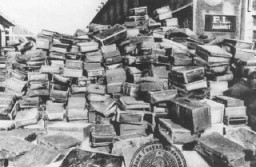
Concentration Camps, 1942–45
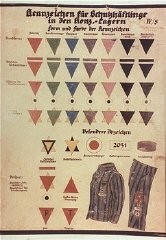
Classification System in Nazi Concentration Camps
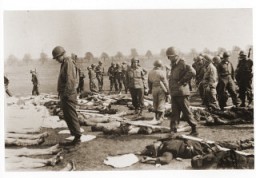
Concentration Camp System: In Depth
Critical thinking questions.
- Concentration camps in these six years were not specifically for Jews. Who was imprisoned there, and why?
- Where were the camps located? To what degree was the German population aware of the camps, their purpose, and the conditions within?
- Did the outside world have any knowledge about these camps? If so, what actions were taken by other countries and their officials? What choices do other countries have in the face of mistreatment of civilians?
Thank you for supporting our work
We would like to thank Crown Family Philanthropies and the Abe and Ida Cooper Foundation for supporting the ongoing work to create content and resources for the Holocaust Encyclopedia. View the list of all donors .
‘Grand Tour’ Review: Miguel Gomes’ Sprawling Travelogue Traverses Space and Time
Cannes 2024: The Portuguese auteur fascinates and frustrates in this meandering and melancholic film

How much can we expect cinema to be fully legible? If history, culture, and existence itself are not so easily parsed, why should the films we make about them be? Is navigating this chaotic life not defined by the both wondrous and wearisome waves of the world crashing over us?
If there was ever a film to capture this, it would be the spellbinding though scattered “Grand Tour” from director Miguel Gomes. His latest is an expansive, sweeping work that bends time, space, genre,and form. It is a wholly uncompromising experience that dances with mirth and melancholy. Proving to be evocative in one moment and unrelentingly exhausting in the next, it’s as gorgeous to behold visually as it is hard to completely embrace thematically. And yet, if you abandon yourself to it by the end as one character says, you can catch glimpses of something spectacularly sublime in the vast journey that it takes on.
Premiering in competition at the 2024 Cannes Film Festival , the story from Gomes and co-writers Mariana Ricardo, Telmo Churro, and Maureen Fazendeiro almost itself becomes incidental. Though Gomes directed much of the film remotely while it was shot during the height of the COVID pandemic, this is not a thoughtful musing on that specific crisis as much as it is a frequently impenetrable exploration of time, place, and two people who also don’t particularly matter.

The first is Edward (Gonçalo Waddington) who has left behind the second, his longtime fiancée Molly (Crista Alfaiate), to set off across the world. The buffoonish British diplomat seems driven by the need to never stop moving, despite the many telegraphs that his fiancée keeps sending him urging him to do so. He will journey to Singapore, Bangkok, Saigon, Manila, Osaka, Shanghai, and more, with narration playing out over all of it until you start to think you’ve got a read on the whole thing. Then a midpoint curveball changes the game, although the shift too remains largely unimportant as it plays as a chilling note of life’s futility.
All of this is what the film is about in a broad sense, but such a strictly linear description of the progression is wildly insufficient to fully capture the many things that Gomes is going for here. Everything feels gargantuan in a rather unwieldy sense, as if these two characters are but mere pawns in a game neither fully understands. The shifting from black-and-white to color, as well as more modern footage to the film’s recreations of the early 1900s, serves this well, embodying just how much there is going on all at once at all times. While one hesitates to call it a satire, this approach feels like it is lightly skewering the superficial romantic story at the core of the film and the long history of cinema that uses various countries as nothing more than a backdrop. Despite the film gesturing towards a reunion between the duo, nothing ends up being so simple.
What tenuously ties the two characters together are the telegrams and the places they each go, though the experiences they have as they do so could not be more different. Edward seems almost perpetually somber whereas Molly embraces silliness, giving the most unique laugh you’ll ever see in a film. There is so much anarchic absurdity to life and the film, that such laughter seems like the right response.
However, just as one character is running away and another is running towards, the film is stronger when we shift to the second half with Molly. The juxtaposition of her experience with Edward’s makes everything feel more pointed and poetic. There is still much that remains abstract, as Gomes remains uninterested in making anything particularly explicit, but that is all by design. Despite our desire to make sense of what can be an impenetrable existence, the onward march of time cares little about what it is that we want from our lives. There is similarly a good chance many will desire more to hold this film together, as much remains frustratingly scattered in Edward’s portion of the film, but it still builds to an absolute showstopper of a finale.
Midway through the film, when Molly goes to get her future read by a psychic, she grows angry at what she is told. Only later do we realize this may be one of the few moments of clarity she actually gets in her life. It’s an audacious conclusion in a film that, while never lacking for boldness, benefits greatly from this final flourish. That it remains beguiling, both for the characters and the audience, feels baked into the experience. We may spend a lifetime grasping for something, only to find it always out of reach. Even if you look to the sky and see the bigger picture, it may be too late.

Leave a Reply Cancel reply
Your email address will not be published. Required fields are marked *
This site uses Akismet to reduce spam. Learn how your comment data is processed .

A Virtual Tour of Auschwitz - Poland's Haunted Concentration Camp
W alking through the gates of Auschwitz isn’t just a sobering experience; it’s a journey back in time to one of the darkest chapters in human history. Located in Oswiecim, Poland , Auschwitz-Birkenau stands as the most infamous of the Nazi concentration and extermination camps. Today, preserved as a museum , this is more than a memorial. It's a constant reminder of the horrors we must never forget. So, in case you don't have the chance to visit this museum yourself, and learn more about it's absolutely horrific history - join us on this virtual journey through Poland's haunted concentration camp.
Entry to Auschwitz I
Our exploration begins at Auschwitz I. This part of the camp is easily recognized by the chilling motto “Arbeit Macht Frei” (Work Sets You Free) arching over its gates. Originally built to house political prisoners, it quickly became the administrative center for the entire camp complex. As you walk past the rows of brick barracks, the stark reality of life here hits you-the isolation cells, the execution wall, and the electrified fences paint a gruesome picture of daily life.
Today, these barracks are converted into exhibition halls that detail the camp’s operation and narrate stories of the inmates. The halls hold personal belongings-luggage, glasses, even children’s shoes-that were seized upon arrival. Perhaps the most haunting exhibit is the massive display of human hair. What a brutal reminder of how camp prisoners were stripped of all humanity. But it wasn't just their hair that was taken from them. Prosthetics, glasses, and even braces - thousands of examples are still in the museum.
Block 11 & Auschwitz II-Birkenau
Block 11, known as the “Death Block,” is where the Nazis carried out brutal punishments and experiments. The standing cells here were particularly torturous-prisoners were crammed into tiny spaces, forced to stand for days. It was also in Block 11 that the initial tests with Zyklon B gas were conducted. This testing set the stage for the mass exterminations that would follow.
Just a short distance away, Auschwitz II-Birkenau was constructed to expedite the Nazis’ Final Solution-the genocide of the Jewish people. The size of Birkenau strikes you as you view the ruins of the gas chambers and crematoria, sinisterly destroyed by the Nazis in an attempt to hide their crimes. The endless rows of chimney stacks stand as silent witnesses to the horrific scenes in this construction of torture.
Reflecting at the Memorial
At the end of the railway line into Birkenau, there’s a poignant International Monument to the Victims. Here, people from around the world pay their respects, leaving stones and flowers in memory of those lost. Finally, it's important to remember Auschwitz was just a small part of a systematic attempt by the Nazi regime to exterminate Jews. This genocidal plan also targeted Romani people, disabled individuals, Polish and Soviet civilians, communists, socialists, Jehovah's Witnesses, and homosexuals.
Exploring Auschwitz isn’t easy, but it's essential. It forces us to confront uncomfortable truths about human capacity for cruelty. It’s a potent reminder of what can happen when hatred goes unchecked. As we walk through these gates, we don’t just learn about history-we vow to make “Never Again” a reality.
The post A Virtual Tour of Auschwitz - Poland’s Haunted Concentration Camp appeared first on Malorie's Adventures .

‘Grand Tour’ Review: Miguel Gomes’ Dreamy, Delirious Time-Swirling Travelogue Through East and Southeast Asia
Bristling with life and song and revelatory collisions between cultures and timeframes, the Portuguese master's Cannes Competition title is a healing balm for trying times.
By Jessica Kiang
Jessica Kiang
- ‘All We Imagine as Light’ Review: A Glowing Portrait of Urban Connection and Unexpected Sisterhood 2 days ago
- ‘The Other Way Around’ Review: A Charming Madrid-Set Meta-Ode to the Optimistic Fallacy of the ‘Good Break-Up’ 2 days ago
- ‘Grand Tour’ Review: Miguel Gomes’ Dreamy, Delirious Time-Swirling Travelogue Through East and Southeast Asia 3 days ago

Popular on Variety
All we know is that, when this low-level British diplomat (who, like all the British characters, whether they hail from London or pine for Yorkshire, speaks in Portuguese) shows up at Mandalay train station, it is 1918, near midnight and he is drunk. The next day, when he goes to pick Molly up from her arriving steamship, his nerve suddenly fails, and before he even claps eyes on her, he scarpers onto the next ship bound for Singapore.
This is the story of “Grand Tour,” but it is not the half of “Grand Tour.” From the beginning, Gomes’ eccentric, puckish sensibilities are in evidence, with every beautifully rendered black-and-white, period-set interior alternating with bustling, bristling contemporary footage of the various towns and countries featured. Between 1918 and now, some of them have changed their names — Burma is now Myanmar, Siam is now Thailand — but none have changed their spirit, a fact that the seemingly reckless but actually deceptively meticulous construction makes clear.
Sometimes in color, sometimes in monochrome, with the narrators speaking the local lingo and knitting Edward and Molly’s colonial-era stories into the Asia of today, we get gorgeous on-the-fly snapshots of modern life across the continent. A rickety Rangoon ferris wheel propelled by hand (and foot). Workers untangling the wires atop Saigon’s overloaded telephone poles. Old Chinese men playing mahjong; Filipino locals riding tuktuks; Lunar New Year fireworks exploding over the Saigon skyline; a portly man in a restaurant moving himself to tears with his karaoke rendition of “My Way” before returning to his noodles, dabbing at wet eyes.
The film also has a recurring motif in the puppet shows that seemingly every culture has developed, and developed differently, as a storytelling medium. There are marionettes and paper silhouettes and two-person representations of — are they turkeys? Ostriches? Who knows? But that we always see the puppeteers as much as we see their puppets seems appropriate to the sense we get, throughout this overflowing cornucopia of worldly pleasures, of a single intelligence, a particular curiosity and a uniquely skewed sense of humor unifying so much that, in our darker moods, might seem actually to divide us.
Gomes shot this extraordinary film in an extraordinary way. Hampered by Covid-era restrictions, a lot of the modern footage — credited to three cinematographers in Rui Poças, Sayombhu Mukdeeprom and Guo Liang — was directed remotely, while the period segments, whether in bamboo forests or Raffles Hotel or aboard a ship whose captain speaks in six different languages over the mooing of a cargo hold full of cows, were creations on a sound stage. But even aside from the occasional deliberate anachronism — like a cellphone dropped in a forest when Molly is on the verge of catching up to Edward — and despite the brash collisions of stock and style, and scripted fiction and found-footage reality, “Grand Tour” is a remarkably coherent, if richly complex experience.
Reviewed at Cannes Film Festival (Competition). May 22, 2024. Running time: 129 MIN.
- Production: (Portugal-Italy-France) An Uma Pedra no Sapato production in co-production with Vivo film, Shellac, Cinéma Defacto. (World sales: Match Factory, Cologne.) Producer: Filipa Reis. Executive Producer: João Miller Guerra. Co-producers: Marta Donzelli, Gregorio Paonessa, Thomas Ordonneau, Tom Dercourt.
- Crew: Director: Miguel Gomes. Screenplay: Mariana Ricardo, Telmo Churro, Maureen Fazendeiro, Miguel Gomes. Camera: Rui Poças, Sayombhu Mukdeeprom, Guo Liang. Editors: Telmo Churro, Pedro Filipe Marques.
- With: Crista Alfaiate, Gonçalo Waddington, Cláudio da Silva, Lang Khê Tran. (Portuguese, Chinese, Thai, French, Burmese, Vietnamese, Filipino, Japanese dialogue)
More From Our Brands
The black keys cancel upcoming north american leg of international players tour, dodgers star shohei ohtani scores a socal estate for $7.8 million, juan soto open to all suitors, but few teams can afford him, the best loofahs and body scrubbers, according to dermatologists, chicago med finale recap: the past is present — plus, grade the episode, verify it's you, please log in.
- Yekaterinburg
- Novosibirsk
- Vladivostok

- Tours to Russia
- Practicalities
- Russia in Lists
Rusmania • Deep into Russia
Out of the Centre
Savvino-storozhevsky monastery and museum.

Zvenigorod's most famous sight is the Savvino-Storozhevsky Monastery, which was founded in 1398 by the monk Savva from the Troitse-Sergieva Lavra, at the invitation and with the support of Prince Yury Dmitrievich of Zvenigorod. Savva was later canonised as St Sabbas (Savva) of Storozhev. The monastery late flourished under the reign of Tsar Alexis, who chose the monastery as his family church and often went on pilgrimage there and made lots of donations to it. Most of the monastery’s buildings date from this time. The monastery is heavily fortified with thick walls and six towers, the most impressive of which is the Krasny Tower which also serves as the eastern entrance. The monastery was closed in 1918 and only reopened in 1995. In 1998 Patriarch Alexius II took part in a service to return the relics of St Sabbas to the monastery. Today the monastery has the status of a stauropegic monastery, which is second in status to a lavra. In addition to being a working monastery, it also holds the Zvenigorod Historical, Architectural and Art Museum.
Belfry and Neighbouring Churches

Located near the main entrance is the monastery's belfry which is perhaps the calling card of the monastery due to its uniqueness. It was built in the 1650s and the St Sergius of Radonezh’s Church was opened on the middle tier in the mid-17th century, although it was originally dedicated to the Trinity. The belfry's 35-tonne Great Bladgovestny Bell fell in 1941 and was only restored and returned in 2003. Attached to the belfry is a large refectory and the Transfiguration Church, both of which were built on the orders of Tsar Alexis in the 1650s.

To the left of the belfry is another, smaller, refectory which is attached to the Trinity Gate-Church, which was also constructed in the 1650s on the orders of Tsar Alexis who made it his own family church. The church is elaborately decorated with colourful trims and underneath the archway is a beautiful 19th century fresco.
Nativity of Virgin Mary Cathedral

The Nativity of Virgin Mary Cathedral is the oldest building in the monastery and among the oldest buildings in the Moscow Region. It was built between 1404 and 1405 during the lifetime of St Sabbas and using the funds of Prince Yury of Zvenigorod. The white-stone cathedral is a standard four-pillar design with a single golden dome. After the death of St Sabbas he was interred in the cathedral and a new altar dedicated to him was added.

Under the reign of Tsar Alexis the cathedral was decorated with frescoes by Stepan Ryazanets, some of which remain today. Tsar Alexis also presented the cathedral with a five-tier iconostasis, the top row of icons have been preserved.
Tsaritsa's Chambers

The Nativity of Virgin Mary Cathedral is located between the Tsaritsa's Chambers of the left and the Palace of Tsar Alexis on the right. The Tsaritsa's Chambers were built in the mid-17th century for the wife of Tsar Alexey - Tsaritsa Maria Ilinichna Miloskavskaya. The design of the building is influenced by the ancient Russian architectural style. Is prettier than the Tsar's chambers opposite, being red in colour with elaborately decorated window frames and entrance.

At present the Tsaritsa's Chambers houses the Zvenigorod Historical, Architectural and Art Museum. Among its displays is an accurate recreation of the interior of a noble lady's chambers including furniture, decorations and a decorated tiled oven, and an exhibition on the history of Zvenigorod and the monastery.
Palace of Tsar Alexis

The Palace of Tsar Alexis was built in the 1650s and is now one of the best surviving examples of non-religious architecture of that era. It was built especially for Tsar Alexis who often visited the monastery on religious pilgrimages. Its most striking feature is its pretty row of nine chimney spouts which resemble towers.

Plan your next trip to Russia
Ready-to-book tours.
Your holiday in Russia starts here. Choose and book your tour to Russia.
REQUEST A CUSTOMISED TRIP
Looking for something unique? Create the trip of your dreams with the help of our experts.
Follow Puck Worlds online:
- Follow Puck Worlds on Twitter
Site search
Filed under:
- Kontinental Hockey League
Gagarin Cup Preview: Atlant vs. Salavat Yulaev
Share this story.
- Share this on Facebook
- Share this on Twitter
- Share this on Reddit
- Share All sharing options
Share All sharing options for: Gagarin Cup Preview: Atlant vs. Salavat Yulaev
Gagarin cup (khl) finals: atlant moscow oblast vs. salavat yulaev ufa.
Much like the Elitserien Finals, we have a bit of an offense vs. defense match-up in this league Final. While Ufa let their star top line of Alexander Radulov, Patrick Thoresen and Igor Grigorenko loose on the KHL's Western Conference, Mytischi played a more conservative style, relying on veterans such as former NHLers Jan Bulis, Oleg Petrov, and Jaroslav Obsut. Just reaching the Finals is a testament to Atlant's disciplined style of play, as they had to knock off much more high profile teams from Yaroslavl and St. Petersburg to do so. But while they did finish 8th in the league in points, they haven't seen the likes of Ufa, who finished 2nd.
This series will be a challenge for the underdog, because unlike some of the other KHL teams, Ufa's top players are generally younger and in their prime. Only Proshkin amongst regular blueliners is over 30, with the work being shared by Kirill Koltsov (28), Andrei Kuteikin (26), Miroslav Blatak (28), Maxim Kondratiev (28) and Dmitri Kalinin (30). Oleg Tverdovsky hasn't played a lot in the playoffs to date. Up front, while led by a fairly young top line (24-27), Ufa does have a lot of veterans in support roles: Vyacheslav Kozlov , Viktor Kozlov , Vladimir Antipov, Sergei Zinovyev and Petr Schastlivy are all over 30. In fact, the names of all their forwards are familiar to international and NHL fans: Robert Nilsson , Alexander Svitov, Oleg Saprykin and Jakub Klepis round out the group, all former NHL players.
For Atlant, their veteran roster, with only one of their top six D under the age of 30 (and no top forwards under 30, either), this might be their one shot at a championship. The team has never won either a Russian Superleague title or the Gagarin Cup, and for players like former NHLer Oleg Petrov, this is probably the last shot at the KHL's top prize. The team got three extra days rest by winning their Conference Final in six games, and they probably needed to use it. Atlant does have younger regulars on their roster, but they generally only play a few shifts per game, if that.
The low event style of game for Atlant probably suits them well, but I don't know how they can manage to keep up against Ufa's speed, skill, and depth. There is no advantage to be seen in goal, with Erik Ersberg and Konstantin Barulin posting almost identical numbers, and even in terms of recent playoff experience Ufa has them beat. Luckily for Atlant, Ufa isn't that far away from the Moscow region, so travel shouldn't play a major role.
I'm predicting that Ufa, winners of the last Superleague title back in 2008, will become the second team to win the Gagarin Cup, and will prevail in five games. They have a seriously well built team that would honestly compete in the NHL. They represent the potential of the league, while Atlant represents closer to the reality, as a team full of players who played themselves out of the NHL.
- Atlant @ Ufa, Friday Apr 8 (3:00 PM CET/10:00 PM EST)
- Atlant @ Ufa, Sunday Apr 10 (1:00 PM CET/8:00 AM EST)
- Ufa @ Atlant, Tuesday Apr 12 (5:30 PM CET/12:30 PM EST)
- Ufa @ Atlant, Thursday Apr 14 (5:30 PM CET/12:30 PM EST)
Games 5-7 are as yet unscheduled, but every second day is the KHL standard, so expect Game 5 to be on Saturday, like an early start.
Loading comments...

IMAGES
VIDEO
COMMENTS
The Grand Tour Visits a German Concentration Camp. Next stop: Jeremy posted a photo to his Instagram account of Stalag Luft 3, a German concentration camp in the town of town of Sagan, Lower Silesia. This continues the WWII theme and should act as a sobering moment in the episode. Around this time the team also visited Krakow.
In their latest adventure-filled episode, "The Grand Tour: Eurocrash," renowned presenters Richard Hammond, Jeremy Clarkson, and James May embark on an exhilarating journey across the captivating landscapes of Europe. Starting their epic road trip in the historic city of Gdańsk, Poland, the trio sets off on a high-octane adventure. From the picturesque streets of Długi […]
End of The Grand Tour: Jeremy Clarkson, along with co-presenters Richard Hammond and James May, will no longer film new series of The Grand Tour after next year, following a decision by Amazon Prime's executives.This marks the end of a popular show that started in 2016 and quickly garnered a devoted fanbase. Fan Reactions and Future Prospects: Fans expressed their disappointment and ...
Ohrdruf. The Ohrdruf camp was a subcamp of the Buchenwald concentration camp, and the first Nazi camp liberated by US troops. The year 2020 marked the 75th anniversary of the liberation of concentration camps by US forces and the end of Nazi tyranny in Europe. The Ohrdruf camp was created in November 1944 near the town of Gotha, Germany.
Each includes tours of Auschwitz I and Auschwitz II-Birkenau. • General tours (2,5 h) • General tours (3,5 h) • Guided tours for individual visitors (3,5 h) • One-day study tours (6 h) • Two-day study tours (2x3 h) • Online tour (2 h) Because of a large number of visitors guides should be reserved at least two months before a ...
The camp was still filled with the bodies of prisoners who had been murdered just before the SS guards fled. The stench of death filled the camp. The raw footage featured here was taken by members of the US Army Signal Corps. At Ohrdruf, Eisenhower received a tour from former prisoners with a US miitary translator.
During a tour of the newly liberated Ohrdruf concentration camp in Germany, an Austrian Jewish survivor describes to General Dwight D. Eisenhower and his entourage the use of the gallows in the camp. ... Eisenhower had studied his World War II enemy, he was unprepared for the Nazi brutality he witnessed at Ohrdruf concentration camp in April ...
The First Concentration Camp. The major purpose of the earliest concentration camps during the 1930s was to incarcerate and intimidate the leaders of political, social, and cultural movements that the Nazis perceived to be a threat to the survival of the regime. The first Nazi concentration camp was Dachau, established in March 1933, near Munich.
Camp System: Maps German authorities under National Socialism established a variety of detention facilities to confine those whom they defined as political, ideological, or racial opponents of the regime.In time their extensive camp system came to include concentration camps, where persons were incarcerated without observation of the standard norms applying to arrest and custody; labor camps ...
A tour lasts approximately 3.5 hours and it starts at Auschwitz I. The price includes a tour of the former Auschwitz I and Auschwitz II-Birkenau camps with a guide-educator, rental of a headset. The Museum provides transfer between both sites of the former camp. The shuttle bus is intended for individual visitors in guided tours.
From 1933 to 1945, Nazi Germany operated more than a thousand concentration camps (German: Konzentrationslager), including subcamps on its own territory and in parts of German-occupied Europe. The first camps were established in March 1933 immediately after Adolf Hitler became Chancellor of Germany.Following the 1934 purge of the SA, the concentration camps were run exclusively by the SS via ...
As the Allies liberated the Nazi death camps, several commanders ordered that local civilians be rounded up and forced to complete a tour of the camps - to reveal what they had been supporting for several years. This New York Times report was filed in Buchenwald on April 18th 1945: BUCHENWALD, Germany. "German civilians, 1200 of them, were ...
In concentration camps across Europe, 6 million Jewish people were killed - around 78% of all Jews in occupied Europe. ... Visitors can tour the grounds and the remains of the camp and audio guides are available as are guided tours. There are several exhibitions detailing the history of the camp as well as a documentary shown at various times.
Main track of Auschwitz-Birkenau. Permanent exhibit at Auschwitz-Birkenau State Museum.. Holocaust tourism is tourism to destinations connected with the extermination of Jews during the Holocaust in World War II, including visits to sites of Jewish martyrology such as former Nazi death camps and concentration camps turned into state museums. It belongs to a category of the so-called 'roots ...
KL Auschwitz was the largest of the German Nazi concentration camps and extermination centers. Over 1.1 million men, women and children lost their lives here. Visiting. The authentic Memorial consists of two parts of the former camp: Auschwitz and Birkenau. A visit with an educator allows better understanding of this unique place.
Tour Introduction. In this 8-day tour to Poland, we visit the sites of the former ghettos in Warsaw, Lublin and Krakow alongside four of the concentration and death camps - Treblinka, Majdanek, Belzec and Auschwitz-Birkenau - that played such a significant role in this genocide. We look at the struggle of both the Jews and the Poles against ...
1. Nazi officials established the first concentration camp, Dachau, on March 22, 1933, for political prisoners. It was later used as a model for an expanded and centralized concentration camp system managed by the SS. 2. What distinguishes a concentration camp from a prison (in the modern sense) is that it functions outside of a judicial system.
His latest is an expansive, sweeping work that bends time, space, genre,and form. It is a wholly uncompromising experience that dances with mirth and melancholy. Proving to be evocative in one ...
A Virtual Tour of Auschwitz - Poland's Haunted Concentration Camp. Walking through the gates of Auschwitz isn't just a sobering experience; it's a journey back in time to one of the darkest ...
With: Crista Alfaiate, Gonçalo Waddington, Cláudio da Silva, Lang Khê Tran. (Portuguese, Chinese, Thai, French, Burmese, Vietnamese, Filipino, Japanese dialogue) Bristling with life, song and ...
Zvenigorod's most famous sight is the Savvino-Storozhevsky Monastery, which was founded in 1398 by the monk Savva from the Troitse-Sergieva Lavra, at the invitation and with the support of Prince Yury Dmitrievich of Zvenigorod. Savva was later canonised as St Sabbas (Savva) of Storozhev. The monastery late flourished under the reign of Tsar ...
Moscow Oblast ( Russian: Моско́вская о́бласть, Moskovskaya oblast) is a federal subject of Russia. It is located in western Russia, and it completely surrounds Moscow. The oblast has no capital, and oblast officials reside in Moscow or in other cities within the oblast. [1] As of 2015, the oblast has a population of 7,231,068 ...
Elektrostal. Elektrostal ( Russian: Электроста́ль) is a city in Moscow Oblast, Russia. It is 58 kilometers (36 mi) east of Moscow. As of 2010, 155,196 people lived there.
Much like the Elitserien Finals, we have a bit of an offense vs. defense match-up in this league Final. While Ufa let their star top line of Alexander Radulov, Patrick Thoresen and Igor Grigorenko loose on the KHL's Western Conference, Mytischi played a more conservative style, relying on veterans such as former NHLers Jan Bulis, Oleg Petrov, and Jaroslav Obsut.